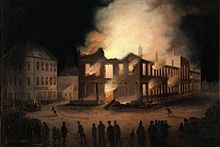Robert Baldwin
The Country party embodied a civic humanism that drew on ancient Greek and Roman conceptions of citizenship, and the value of selfless political participation for the public good; those selfish few who placed their private interests before the public good threatened the moral commitment of all citizens to political participation.
It was similar to American conceptions of “civic republicanism” as they developed after the revolution among Jacksonian Democrats, as well as in the Chartist movement in Britain in the late 1830s.
Municipal government in Upper Canada was under the control of appointed magistrates who sat in Courts of Quarter Sessions to administer the law within a District.
It also established a hierarchy of types of municipal governments, starting at the top with cities and continued down past towns, villages and finally townships.
Despite this inauspicious start, his adherence to principle and his fearlessness in the face of Orange Order electoral violence won him the loyalty of voters in the post-Rebellion period.
After losing his seat in the 1830 election, Baldwin withdrew to his private legal practice until his wife's death as a result of a Caesarian in 1836.
Two weeks after Eliza Baldwin's death, Sir Francis Bond Head (1793–1875) arrived as the new Lieutenant Governor, to address reform grievances.
Governor waded into the electoral fray, and with the use of Orange Order polling violence, expunged the reformers from the Legislative Assembly.
Governor, carrying a flag of truce to the rebel camp north of Toronto on 5 December 1837, but failed to head off an armed clash.
In response to Durham's Report, the British Government appointed Charles Poulett Thomson (later Lord Sydenham) as Governor with two main tasks.
And secondly, he was to strengthen British rule by imposing a new system of centrally controlled District Councils that would take much of the elected Assembly's legislative purview, leaving it little to do but approve the Governor's budgets.
[16] Orange Order riots during the Toronto civic elections in January 1841 convinced Baldwin he could never win a seat in the city.
In Canada East, gerrymandering and Orange Order violence were used to prevent the election of Louis-Hippolyte LaFontaine, leader of the Canadien reformers in Terrebonne, outside Montreal.
On 3 September 1841, the Children of Peace held a campaign rally for Baldwin and LaFontaine in their Temple, where they rejoiced "to say that we have it in our power to show our impartial respect to the Canadian people of the Lower Province."
His replacement, Sir Charles Bagot, was not able to form a mixed cabinet of Reformers and Tories, and so he was forced to include the "Canadien party" under LaFontaine.
Bagot was finally forced to accede in September 1842, and when he became severely ill thereafter, Baldwin and Lafontaine became the first real premiers of the Province of Canada.
While LaFontaine was easily re-elected in 4th York, Baldwin lost his seat in Hastings as a result of Orange Order violence.
It was now that the pact between the two men was completely solidified, as LaFontaine arranged for Baldwin to run in Rimouski, a constituency in a heavily francophone area of Canada East.
Lacking the scale of the American Revolution, it nonetheless forced a comparable articulation and rethinking of the basics of political dialogue in the province.”[22] During the year-long crisis, Metcalfe was to champion the Sydenham system and its conceptions of a limited, liberal capitalist government accountable to the imperial state, not the local Assembly; he continued to govern, demonstrating the irrelevance of Parliament.
It sparked Orange riots, and the burning of the Parliament buildings as much of Europe was similarly engulfed in a wave of republican revolutions and counter-revolutions.
The special struggle leading to his resignation was an attempt to abolish the Court of Chancery of Upper Canada, whose constitution was due to a measure introduced by Baldwin in 1849.
The attempt, though defeated, had been supported by a majority of the representatives from Upper Canada, and Baldwin's fastidious conscience took it as a vote of confidence.
After the concession of responsible government, he devoted himself to bringing about a good understanding between the English and French-speaking inhabitants of Canada, and his memory is held as dear among the French Canadians as in his native province of Ontario.
John Ralston Saul pointed out in the inaugural LaFontaine-Baldwin Symposium, that “we have killed in political strife among ourselves less than a hundred citizens – most of them on a single day at Batoche,” Saskatchewan, during the Riel Rebellion.
“The first measure of any citizen-based culture” he adds, “must not be its rhetoric or myths or leaders or laws but how few of its citizens it kills.” This non-violent tradition we owe to Robert Baldwin and Louis-Hippolyte LaFontaine, who refused to abandon principle, and who walked away from retribution.


1st Earl of Durham.





